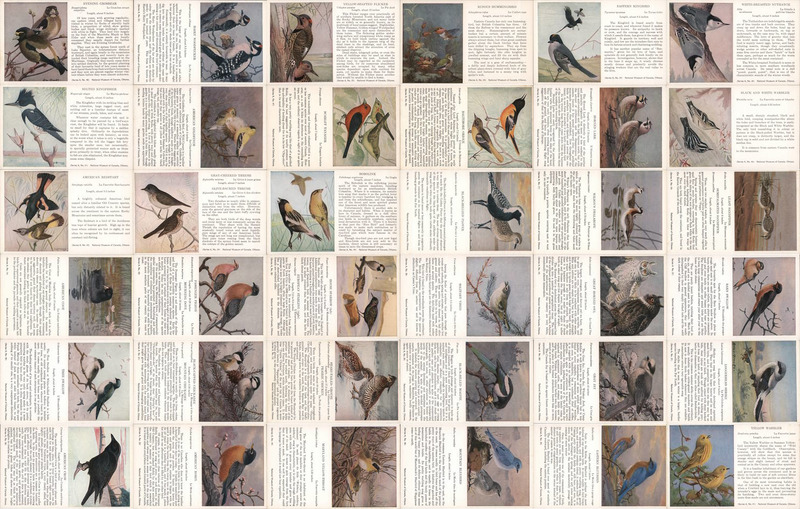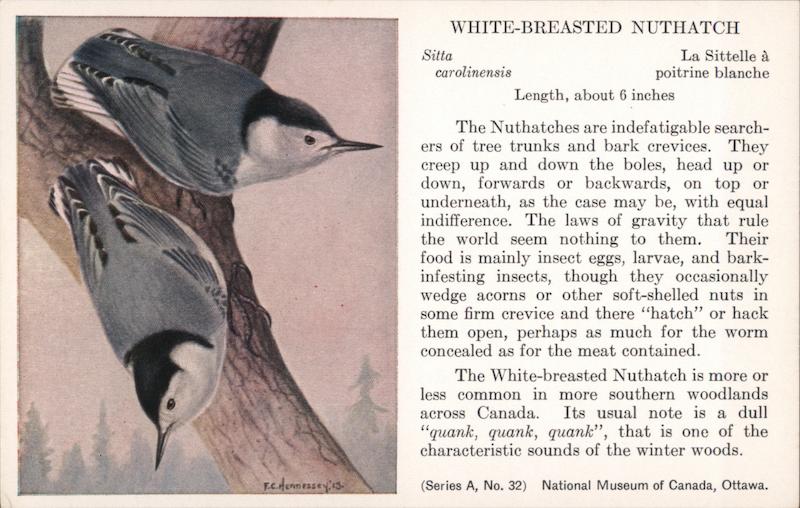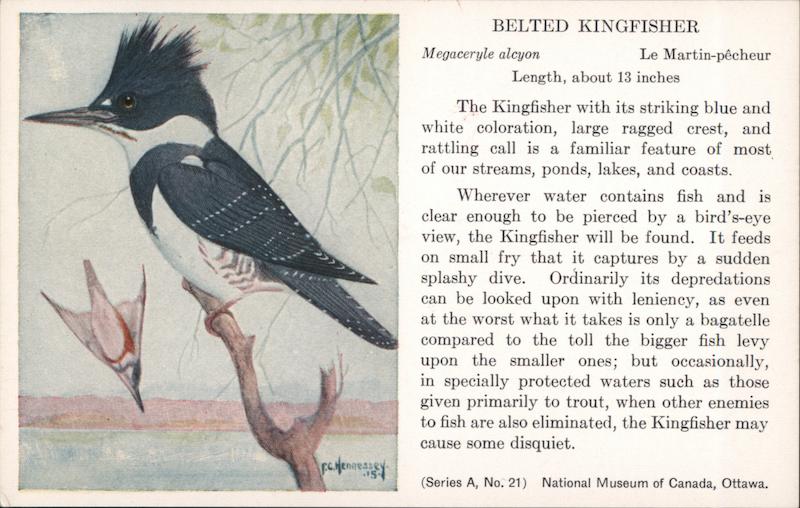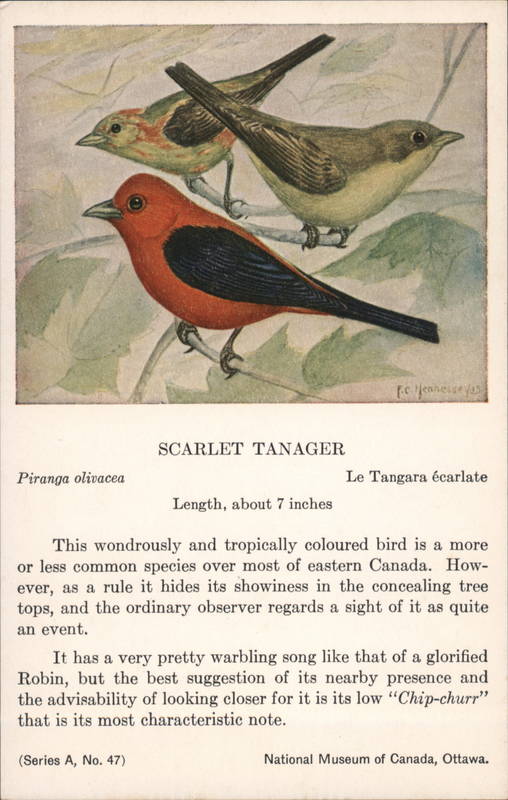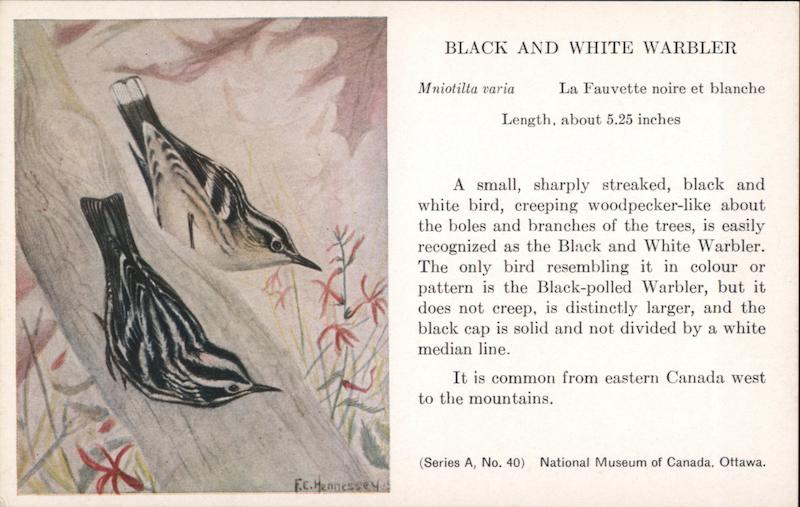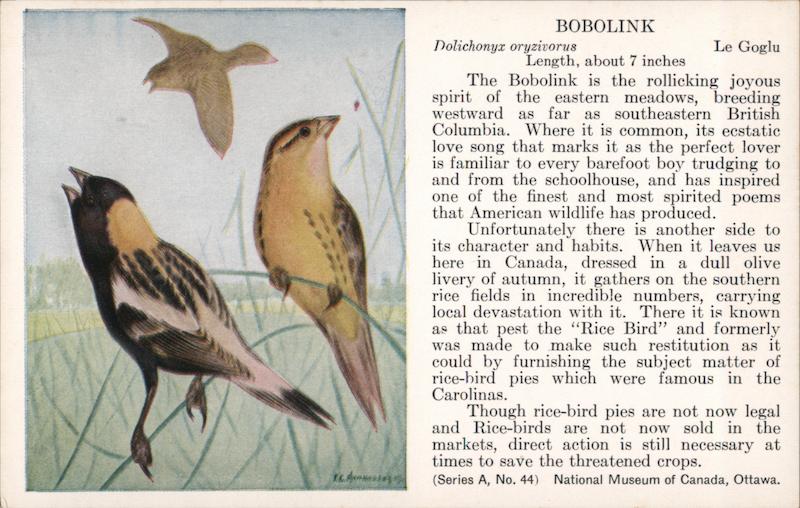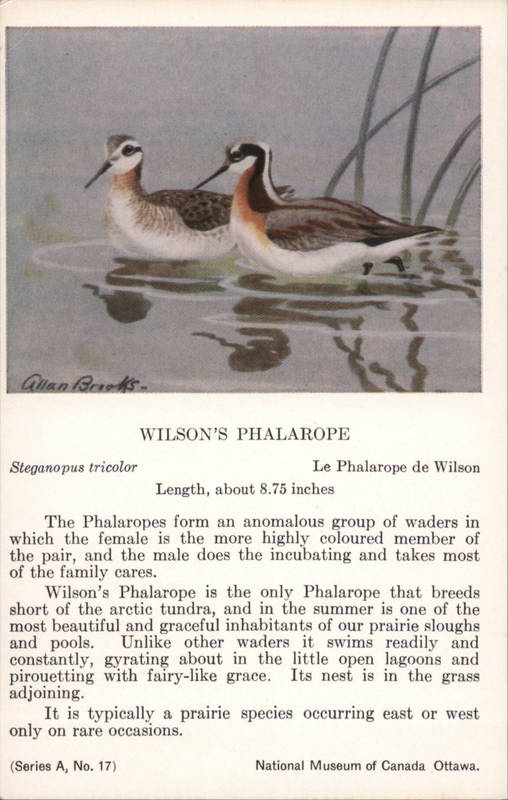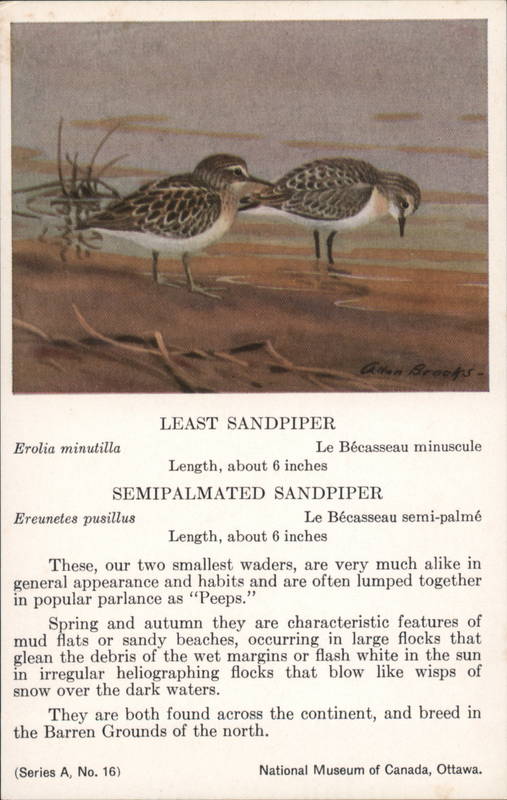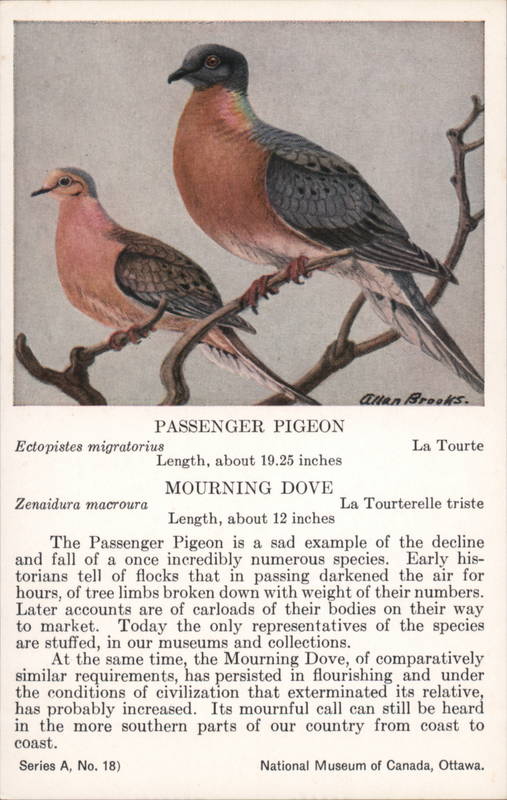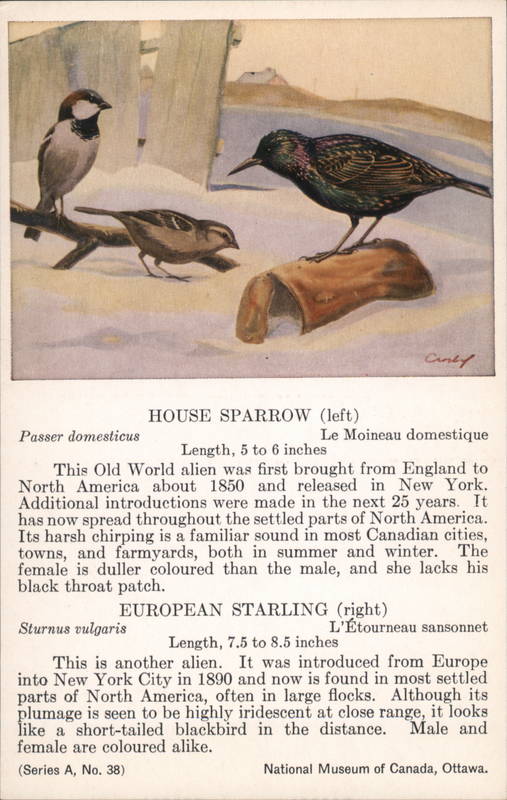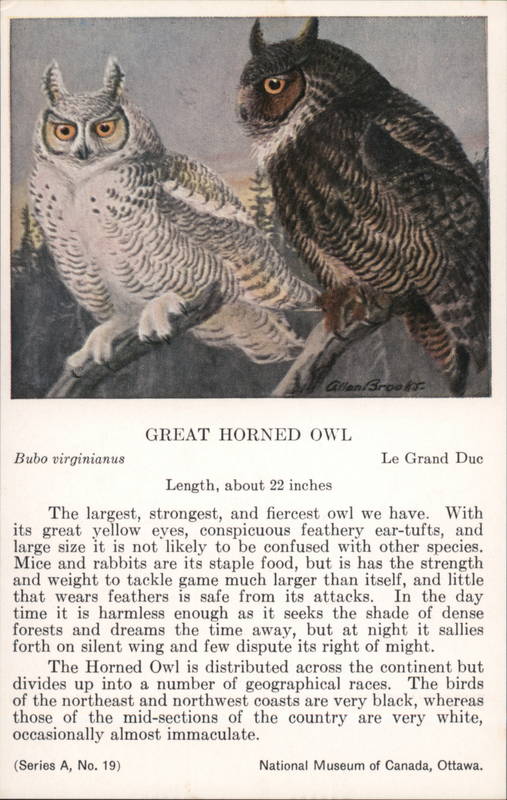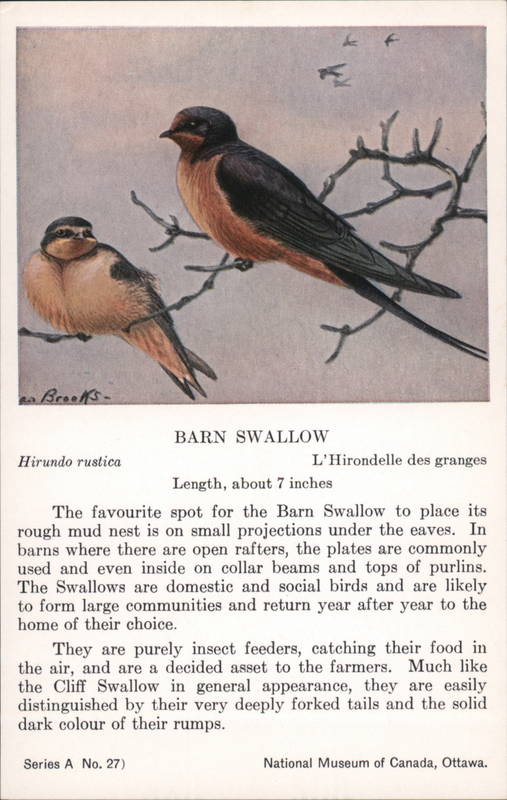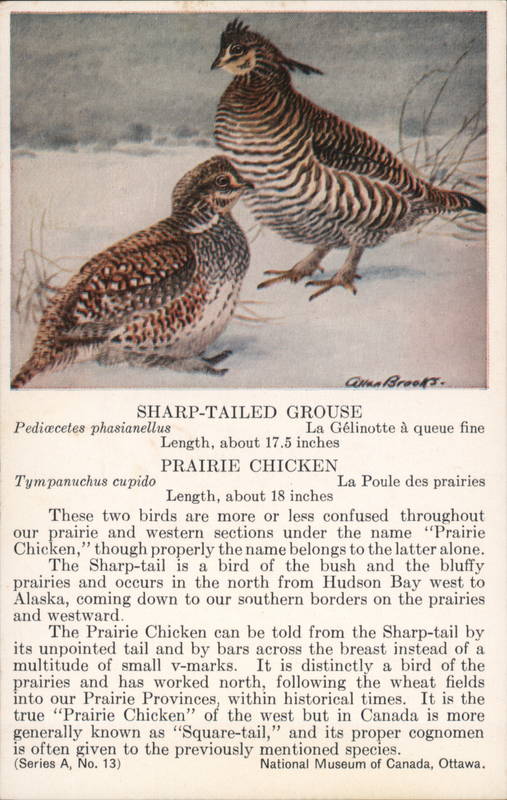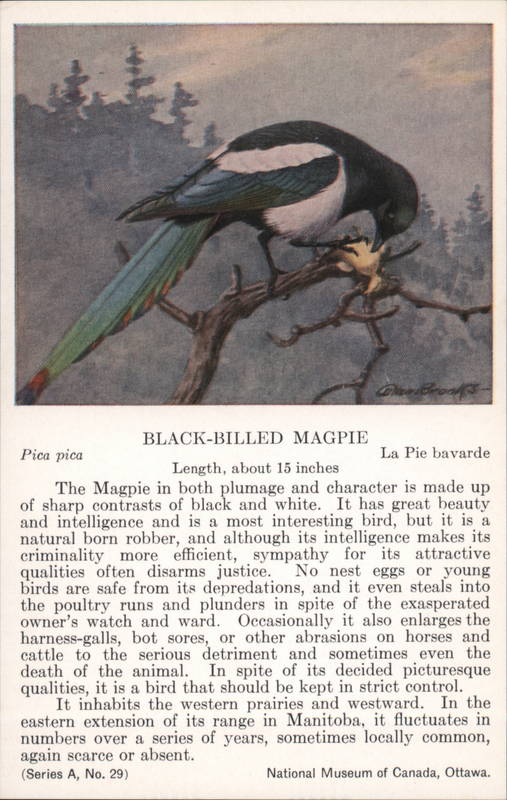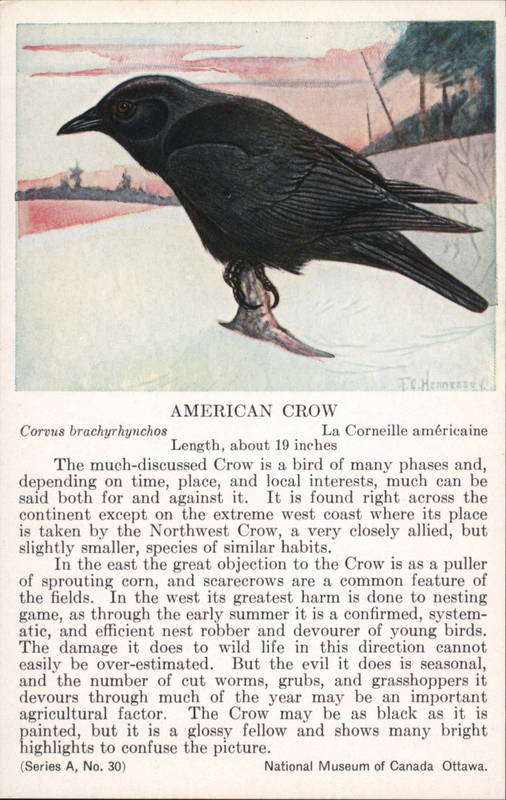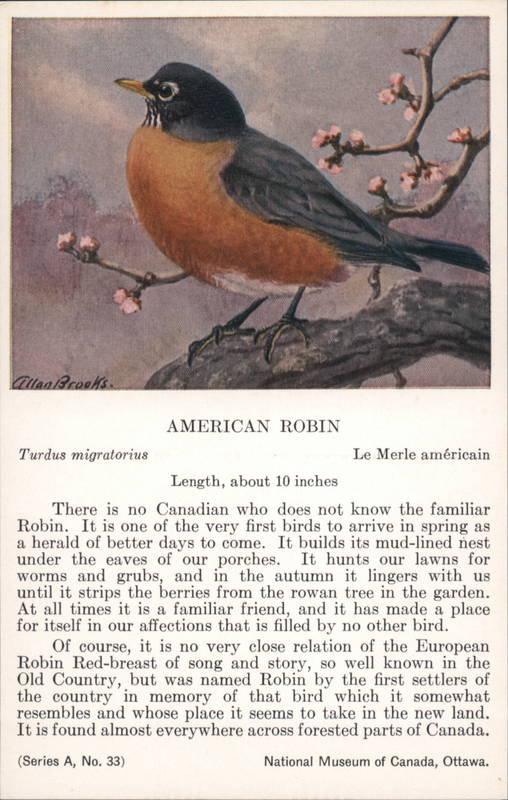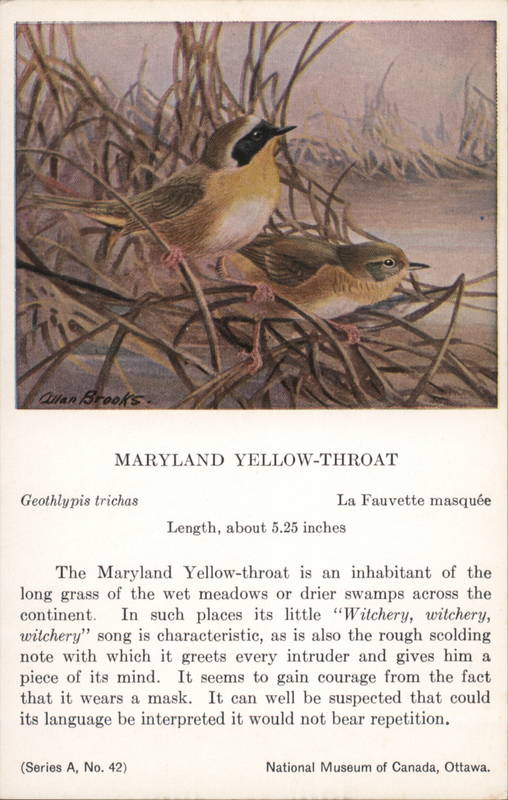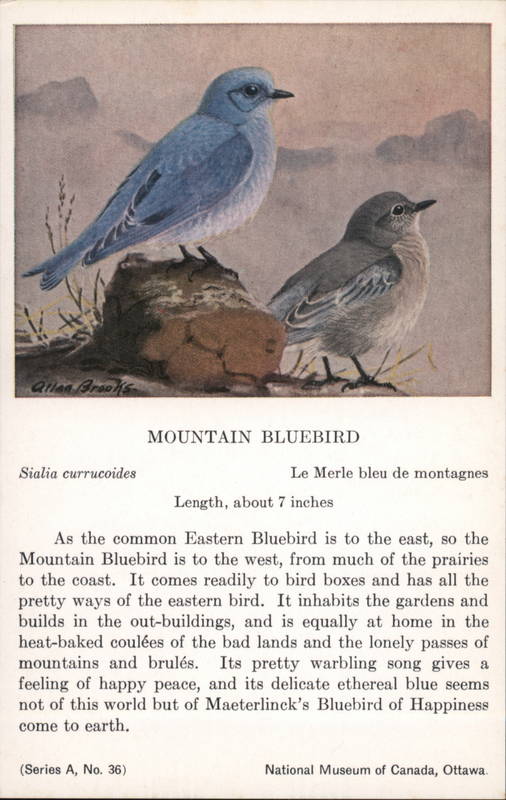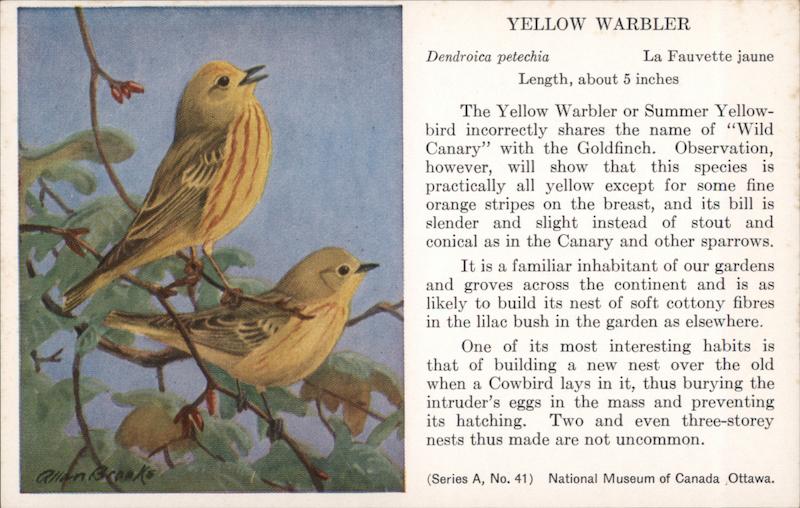Lot of 36: National Museum of Canada Birds
Front:
Allan Brooks
EVENING GROSBEAK
Hesperiphona
vespertina
Le Gros-bec errant
Length, about 8 inches
Of late years, with growing regularity,
our eastern cities and villages have been
visited in winter by flocks of sturdily built
birds, a proportion of which show golden
bodies and black wings strikingly marked
with white in flight. They feed very largely
on the fruit of the Manitoba Maple or Box
Elder and when these seeds are locally
consumed they usually depart for further
supplies. They are Evening Grosbeaks.
They nest in the spruce forest north of
Lake Superior, an indeterminate distance
westward, and again locally in the mountains
of British Columbia, and recently have ex-
tended their breeding range eastward to the
Maritimes. Originally they rarely came down
into settled districts, by the general planting
of their favourite food of late years seems to
have lured them from their northern fastnesses,
and they now are almost regular winter visi-
tors where before they were almost unknown.
(Series A, No. 48) National Museum of Canada, Ottawa.
Allan Braaks
Dendrocopos villosus
HAIRY WOODPECKER
Length, about 9.5 inches
Le Pic chevelu
This is the larger of our two small, black and white
spotted woodpeckers. In one form or another it is common
wherever there are trees in Canada. It is a familiar sight
in our garden and city shade trees and in our orchards.
Economically, it is entirely favourable to man. It may
dig into the tree trunks but never without due cause and
only to remove some deep-seated grub that is already under-
mining a fair exterior and threatening the tree's existence.
The Hairy Woodpeckers of the far west are darker by
colour than the eastern ones, and the whites are distinctly
smoky in tone instead of pure. This form is known as
Harris's Hairy Woodpecker.
(Series A, No. 23)
National Museum of Canada Ottawa.
K.C.Hennessey. 15-
YELLOW-SHAFTED FLICKER
Le Pic doré
Colaptes auratus
Length, about 12 inches
This Flicker ranges over practically all
of northern forested North America east of
the Rocky Mountains, and not many birds
are so widely or so generally known, as its
multitude of local names suggest. Highholder,
Yellow Hammer, Golden-winged Woodpecker
are the commoner and more distinctive of
these terms. The flickering golden under-
wing surface and conspicuous white rump as
it flies, its bold black outline against the
sky as it holds to the tipmost twig of the
dead trees in the slashings, and its loud,
strident calls attract the attention of even
the casual observer.
Dead stubs, telegraph poles, or even the
sides of buildings may be used as sites in
which to excavate the nest. Indeed, the
Flicker may be regarded as the carpenter
among birds, for its numerous abandoned
nest-holes are occupied by many other
species dependent upon such cavities for
nests, yet unable to make them for them-
selves. Without the Flicker many another
bird would be unable to find a home.
(Series A, No. 22) National Museum of Canada, Ottawa.
Allan Broo
RUFOUS HUMMINGBIRD
Selasphorus rufus
Le Colibri roux
Length, about 3.5 inches
Of
Eastern Canada has only one humming-
bird, but British Columbia has three.
these the Rufous is the commonest and the
most showy. Hummingbirds are nectar-
feeders but a certain amount of minute
insects is necessary to their welfare. Flowers
always attract them, but often great numbers
gather about the black birches that have
been drilled by sapsuckers. They sip from
the dripping boughs, humming from spot to
spot, fight furiously like elfin knights in
jewelled armour, and fill the air with their
humming wings and faint sharp squeaks.
The nest is a gem of craftsmanship-
a deftly and deeply hollowed knob of the
softest plant-down covered with bits of grey
lichen and fastened to a mossy twig with
spider's web.
(Series A, No. 20) National Museum of Canada, Ottawa.
EASTERN KINGBIRD
Tyrannus tyrannus
Le Tyran tritri
F.C.Henness
Length, about 8.5 inches
The Kingbird is found nearly from
coast to coast, and wherever found it makes
its presence known. Its antipathy to hawk
or crow, and the courage and success with
which it assails them, has given it the name of
Kingbird. It guards its territory well and
noisily, and few are the intruders that care to
face its furious attack and chattering scolding.
It has another popular name of "Bee-
martin," given for its love of bees, and
apiarists do not generally look kindly on its
presence. Investigation, however, shows that
in the bees it snaps up, it wisely chooses
mostly drones and prudently avoids the
stinging workers that are the real value to
the hive.
(Series A, No. 24) National Museum of Canada, Ottawa.
F.C.Hennessey. 13.
Sitta
WHITE-BREASTED NUTHATCH
carolinensis
La Sittelle à
poitrine blanche
Length, about 6 inches
The Nuthatches are indefatigable search-
ers of tree trunks and bark crevices. They
creep up and down the boles, head up or
down, forwards or backwards, on top or
underneath, as the case may be, with equal
indifference. The laws of gravity that rule
the world seem nothing to them. Their
food is mainly insect eggs, larvae, and bark-
infesting insects, though they occasionally
wedge acorns or other soft-shelled nuts in
some firm crevice and there "hatch" or hack
them open, perhaps as much for the worm
concealed as for the meat contained.
The White-breasted Nuthatch is more or
less common in more southern woodlands
across Canada. Its usual note is a dull
"quank, quank, quank", that is one of the
characteristic sounds of the winter woods.
(Series A, No. 32) National Museum of Canada, Ottawa.
54
BELTED KINGFISHER
Megaceryle alcyon
Le Martin-pêcheur
Length, about 13 inches
The Kingfisher with its striking blue and
white coloration, large ragged crest, and
rattling call is a familiar feature of most
of our streams, ponds, lakes, and coasts.
Wherever water contains fish and is
clear enough to be pierced by a bird's-eye
view, the Kingfisher will be found. It feeds
on small fry that it captures by a sudden
splashy dive. Ordinarily its depredations
can be looked upon with leniency, as even
at the worst what it takes is only a bagatelle
compared to the toll the bigger fish levy
upon the smaller ones; but occasionally,
in specially protected waters such as those
given primarily to trout, when other enemies
to fish are also eliminated, the Kingfisher may
cause some disquiet.
(Series A, No. 21) National Museum of Canada, Ottawa.
Glian Brooks
AMERICAN GOLDFINCH
Spinus tristis
Le Chardonneret jaune
Length, about 5 inches
The Goldfinch, Thistle Bird, or Wild Canary is a familiar
figure over most cultivated parts of Canada. Goldfinch is a
name given in memory of a somewhat similar but entirely
different bird of the Old Country. Thistle Bird suggests one
of its favourite foods, though sunflower seeds are its delight.
"Wild Canary" has an obvious derivation, though it is not a
very close relative of that familiar species. A bird it may be
confused with is the Yellow Warbler or Summer Yellow-bird,
but note that that species is all yellow and lacks the black
wings, tail, and jaunty cap.
The Goldfinch is a delightful little fellow, usually going
in small groups or little flocks, with pretty ways and cheery
and canary-like chirps and song. A row of sunflowers in the
garden is a never failing attraction to it in fruit time, though
seeding lettuce heads or many garden seeds are appreciated.
(Series A, No. 49)
National Museum of Canada, Ottawa.
fc Hennesseys
SCARLET TANAGER
Piranga olivacea
Le Tangara écarlate
Length, about 7 inches
This wondrously and tropically coloured bird is a more
or less common species over most of eastern Canada. How-
ever, as a rule it hides its showiness in the concealing tree
tops, and the ordinary observer regards a sight of it as quite
an event.
It has a very pretty warbling song like that of a glorified
Robin, but the best suggestion of its nearby presence and
the advisability of looking closer for it is its low "Chip-churr"
that is its most characteristic note.
(Series A, No. 47)
National Museum of Canada, Ottawa.
F.C.ennessey..15.
Icterus galbula
BALTIMORE ORIOLE
Length, about 7.5 inches
L'Oriole de Baltimore
Named after Lord Baltimore, the patron of the early
settlement of Maryland, whose bright livery it wears, the
Baltimore Oriole is a bird of the east, extending in Canada to
the base of the Rocky mountains. It is particularly a bird
of the park lands, and great trees standing isolated or in
clumps, especially elms, are its delight. Its nest is a work
of art. Felted, and woven of vegetable fibre, wool, string,
or any kind of fluff, it forms a substantial deep bag suspended
at the ends of long, lithe, or weeping bough tips where even
the red squirrel dare not go. In the branches the brilliant
male sings throughout the summer, demonstrating with its
clear, flute-like whistles that bright feather and beautiful
voice can go together. In the winter, while it is sojourning in
the warmth of South America, its deserted nest whips and
cracks at the ends of the long, lash-like stems, defying with
its perfect workmanship the storms of successive seasons
that scatter lesser structures in fragments over the ground.
(Series A, No. 46).
National Museum of Canada, Ottawa.
Allan Brooks
Eremophila alpestris
HORNED LARK
Length, about 7.75 inches
L'Alouette cornue
The Horned Lark is distinctly a bird of the prairies
and probably originally was more or less confined to the
treeless mid-continent and the high barrens north, but with
the advent of civilization and the disappearance of the
eastern forests it has spread eastward over the artificial
man-made prairies thus established. Now throughout the
fields of southern Ontario and Quebec and across the con-
tinent, in one form or another it is a fairly common bird.
In the winter, large flocks come down from the barrens
of the north but show slightly different characters from those
of the resident or breeding birds.
Horned Larks are easily recognized by the prominent
feather tufts like miniature horns at the sides of the head.
They are very early breeders, often nesting before snow is
quite off the ground, and have an interesting flight song
suggestive of that of the Skylark of Europe.
(Series A, No. 25)
National Museum of Canada, Ottawa.
BLACK AND WHITE WARBLER
Mniotilta varia
La Fauvette noire et blanche
Length, about 5.25 inches
A small, sharply streaked, black and
white bird, creeping woodpecker-like about
the boles and branches of the trees, is easily
recognized as the Black and White Warbler.
The only bird resembling it in colour or
pattern is the Black-polled Warbler, but it
does not creep, is distinctly larger, and the
black cap is solid and not divided by a white
median line.
It is common from eastern Canada west
to the mountains.
F.C.Hennessey
(Series A, No. 40) National Museum of Canada, Ottawa.
AMERICAN REDSTART
Setophaga ruticilla
La Fauvette flamboyante
EcHennessy
Length, about 5.5 inches
A brightly coloured American bird
named after a familiar Old Country species,
but only distantly related to it. It is found
across the continent to the eastern Rocky
Mountains and sometimes across them.
The Redstart is a bird of the deciduous
tree tops of heavier growth. High up in the
trees where colours are lost to sight, it can
often be recognized by its restlessness and
constant tail-flirting.
(Series A, No. 43) National Museum of Canada, Ottawa.
C.Hennessey
GRAY-CHEEKED THRUSH
Hylocichla minima
La Grive à joues grises
Length, about 7 inches
OLIVE-BACKED THRUSH
Hylocichla ustulata
La Grive à dos olivâtre
Length, about 7 inches
Two thrushes so nearly alike in appear-
ance and habit as to make them difficult of
distinction one from the other. However,
note the general greyness on the side of the
face of the one and the faint buffy eye-ring
on the other.
They are both birds of the deep woods
and occur more or less commonly across the
continent. They share with the Hermit
Thrush the reputation of having the most
musically toned voices and most liquidly
pure songs of any of our American birds.
The songs are not long nor complicated, but
their pure tones coming from the black
shadows of the spruce forest seem to match
the colours of the golden sunset.
(Series A, No. 34) National Museum of Canada, Ottawa.
BOBOLINK
Dolichonyx oryzivorus
Length, about 7 inches
Le Goglu
The Bobolink is the rollicking joyous
spirit of the eastern meadows, breeding
westward as far as southeastern British
Columbia. Where it is common, its ecstatic
love song that marks it as the perfect lover
is familiar to every barefoot boy trudging to
and from the schoolhouse, and has inspired
one of the finest and most spirited poems
that American wildlife has produced.
Unfortunately there is another side to
its character and habits. When it leaves us
here in Canada, dressed in a dull olive
livery of autumn, it gathers on the southern
rice fields in incredible numbers, carrying
local devastation with it. There it is known
as that pest the "Rice Bird" and formerly
was made to make such restitution as it
could by furnishing the subject matter of
rice-bird pies which were famous in the
Carolinas.
Though rice-bird pies are not now legal
and Rice-birds are not now sold in the
markets, direct action is still necessary at
times to save the threatened crops.
(Series A, No. 44) National Museum of Canada, Ottawa.
Allan Branks
BLACK-BELLIED PLOVER
Squatarola squatarola
Le Pluvier à ventre noir
Length, about 11 inches
The Black-bellied Plover in its differing seasonal plumages
is so much like the Golden Plover that the general observer
is very likely to confuse them. The most obvious character
of this species is the black spot of the axillaries under the
wing and the white rump, both quite visible under ordinarily
favourable conditions in flight.
The species is found more or less commonly in migration
across the continent on its seasonal flights to and from its
breeding grounds in the Far North.
(Series A, No. 15)
National Museum of Canada, Ottawa.
Allan Bricks-
WILSON'S PHALAROPE
Steganopus tricolor
Le Phalarope de Wilson
Length, about 8.75 inches
The Phalaropes form an anomalous group of waders in
which the female is the more highly coloured member of
the pair, and the male does the incubating and takes most
of the family cares.
Wilson's Phalarope is the only Phalarope that breeds
short of the arctic tundra, and in the summer is one of the
most beautiful and graceful inhabitants of our prairie sloughs
and pools. Unlike other waders it swims readily and
constantly, gyrating about in the little open lagoons and
pirouetting with fairy-like grace. Its nest is in the grass
adjoining.
It is typically a prairie species occurring east or west
only on rare occasions.
(Series A, No. 17)
National Museum of Canada Ottawa.
Attan Brooks-
LEAST SANDPIPER
Erolia minutilla
Le Bécasseau minuscule
Length, about 6 inches
SEMIPALMATED SANDPIPER
Ereunetes pusillus
Le Bécasseau semi-palmé
Length, about 6 inches
These, our two smallest waders, are very much alike in
general appearance and habits and are often lumped together
in popular parlance as "Peeps."
Spring and autumn they are characteristic features of
mud flats or sandy beaches, occurring in large flocks that
glean the debris of the wet margins or flash white in the sun
in irregular heliographing flocks that blow like wisps of
snow over the dark waters.
They are both found across the continent, and breed in
the Barren Grounds of the north.
(Series A, No. 16)
National Museum of Canada, Ottawa.
Fulica americana
AMERICAN COOT
Allan Brooks.
La Foulque américaine
Length, about 15 inches
The Coot or Mud-hen looks like a duck and is often
mistaken for it by the general observer. In summer it
inhabits the reed-beds of our sloughs and marshes, swimming
the channels and gliding familiarly through their tangled
density with almost mysterious ease. As nesters the birds
are aggressive, guard their chosen territory well, and seem
to be respected if not feared by their bird neighbours. In
the autumn they gather in dense flocks out on the broader
water, sometimes looking like black rafts at sea.
Coots are not generally regarded as legitimate game
birds by experienced gunners, and their pursuit is usually left
to the pot-hunter and the juvenile or budding sportsman.
(Series A, No. 14)
National Museum of Canada, Ottawa.
PASSENGER PIGEON
Ectopistes migratorius
Allan Brooks.
La Tourte
Length, about 19.25 inches
Zenaidura macroura
MOURNING DOVE
Length, about 12 inches
La Tourterelle triste
The Passenger Pigeon is a sad example of the decline
and fall of a once incredibly numerous species. Early his-
torians tell of flocks that in passing darkened the air for
hours, of tree limbs broken down with weight of their numbers.
Later accounts are of carloads of their bodies on their way
to market. Today the only representatives of the species
are stuffed, in our museums and collections.
At the same time, the Mourning Dove, of comparatively
similar requirements, has persisted in flourishing and under
the conditions of civilization that exterminated its relative,
has probably increased. Its mournful call can still be heard
in the more southern parts of our country from coast to
coast.
Series A, No. 18)
National Museum of Canada, Ottawa.
Cinty
Passer domesticus
HOUSE SPARROW (left)
Length, 5 to 6 inches
Le Moineau domestique
This Old World alien was first brought from England to
North America about 1850 and released in New York.
Additional introductions were made in the next 25 years. It
has now spread throughout the settled parts of North America.
Its harsh chirping is a familiar sound in most Canadian cities,
towns, and farmyards, both in summer and winter. The
female is duller coloured than the male, and she lacks his
black throat patch.
EUROPEAN STARLING (right)
Sturnus vulgaris
L'Étourneau sansonnet
Length, 7.5 to 8.5 inches
This is another alien. It was introduced from Europe
into New York City in 1890 and now is found in most settled
parts of North America, often in large flocks. Although its
plumage is seen to be highly iridescent at close range, it looks
like a short-tailed blackbird in the distance. Male and
female are coloured alike.
(Series A, No. 38)
National Museum of Canada, Ottawa.
Allan Brooks-
Vireo solitarius
SOLITARY VIREO
Length, about 5.5 inches
Le Vireo à tête bleue
Among the flocks of warblers that pass through the
woods and orchards, spring and autumn, are some similar but
rather heavier and less active birds dressed in full olive
greens and yellows. These are likely to be vireos, of which
there are several species. The slate-blue head with rather
conspicuous white facial spot are the distinctive characters of
the Solitary Vireo.
This bird is found in the woodlands across the continent.
The British Columbian representative of the species is
slightly different from the eastern one and is known in
distinction as Cassin's Vireo.
(Series A, No. 39)
National Museum of Canada, Ottawa.
Allen Brooks
Bubo virginianus
GREAT HORNED OWL
Length, about 22 inches
Le Grand Duc
The largest, strongest, and fiercest owl we have. With
its great yellow eyes, conspicuous feathery ear-tufts, and
large size it is not likely to be confused with other species.
Mice and rabbits are its staple food, but is has the strength
and weight to tackle game much larger than itself, and little
that wears feathers is safe from its attacks. In the day
time it is harmless enough as it seeks the shade of dense
forests and dreams the time away, but at night it sallies
forth on silent wing and few dispute its right of might.
The Horned Owl is distributed across the continent but
divides up into a number of geographical races. The birds
of the northeast and northwest coasts are very black, whereas
those of the mid-sections of the country are very white,
occasionally almost immaculate.
(Series A, No. 19)
National Museum of Canada, Ottawa.
Brooks-
BARN SWALLOW
Hirundo rustica
L'Hirondelle des granges
Length, about 7 inches
The favourite spot for the Barn Swallow to place its
rough mud nest is on small projections under the eaves. In
barns where there are open rafters, the plates are commonly
used and even inside on collar beams and tops of purlins.
The Swallows are domestic and social birds and are likely
to form large communities and return year after year to the
home of their choice.
They are purely insect feeders, catching their food in
the air, and are a decided asset to the farmers. Much like
the Cliff Swallow in general appearance, they are easily
distinguished by their very deeply forked tails and the solid
dark colour of their rumps.
Series A No. 27)
National Museum of Canada, Ottawa.
Allan Brooks
TREE SWALLOW
Iridoprocne bicolor
L'Hirondelle bicolore
Length, about 6 inches
The Tree Swallow or White-bellied Swallow is a hole-
nester. Its natural nesting places are hollows in isolated
dead trees, or old woodpecker holes wherever found in the
open. It comes readily to bird boxes and is probably the
most common tenant of such structures in our gardens.
The flashing white of its vest and underparts, in contrast
with the steely gleam of its back above, and its pretty
twittering warbles in the very early spring make it a most
attractive bird to have about. It is often mistaken for the
Purple Martin by those unfamiliar with birds, but the pure
white instead of dark grey or solid black breast, to say
nothing of its smaller size, is a very conspicuous distinction.
(Series A, No. 26)
National Museum of Canada, Ottawa.
Allan Brooks
BLACK-CAPPED CHICKADEE
Parus atricapillus
Parus gambeli
La Mésange à tête noire
Length, about 5.25 inches
MOUNTAIN CHICKADEE
La Mésange de montagnes
Length, about 5.25 inches
These two chickadees are so nearly alike in form, colour,
and habit as to bear treatment together. The Black-capped
extends across the continent practically from coast to coast.
The Mountain Chickadee is confined to the western moun-
tains. They are both permanent residents wherever found
and do not migrate in winter.
The chickadee is the merriest and happiest denizen of
the woods. No matter what the weather may be, its soft
"Chickadee-dee-dee" or its sweet, clear "Spring's here" is
always cheery and bright. It hangs from the airiest branch-
tips and swings right or wrong side up, with equal ease, while
it investigates with microscopic eye for minute insect food
that might grow large and great with damaging possibilities.
(Series A No. 31)
National Museum of Canada, Ottawa.
Allan Brooks
SHARP-TAILED GROUSE
Pediacetes phasianellus
Tympanuchus cupido
La Gélinotte à queue fine
Length, about 17.5 inches
PRAIRIE CHICKEN
La Poule des prairies
Length, about 18 inches
These two birds are more or less confused throughout
our prairie and western sections under the name "Prairie
Chicken," though properly the name belongs to the latter alone.
The Sharp-tail is a bird of the bush and the bluffy
prairies and occurs in the north from Hudson Bay west to
Alaska, coming down to our southern borders on the prairies
and westward.
The Prairie Chicken can be told from the Sharp-tail by
its unpointed tail and by bars across the breast instead of a
multitude of small v-marks. It is distinctly a bird of the
prairies and has worked north, following the wheat fields
into our Prairie Provinces, within historical times. It is the
true "Prairie Chicken" of the west but in Canada is more
generally known as "Square-tail," and its proper cognomen
is often given to the previously mentioned species.
(Series A, No. 13)
National Museum of Canada, Ottawa.
Pica pica
BLACK-BILLED MAGPIE
Length, about 15 inches
Car Brooks
La Pie bavarde
The Magpie in both plumage and character is made up
of sharp contrasts of black and white. It has great beauty
and intelligence and is a most interesting bird, but it is a
natural born robber, and although its intelligence makes its
criminality more efficient, sympathy for its attractive
qualities often disarms justice. No nest eggs or young
birds are safe from its depredations, and it even steals into
the poultry runs and plunders in spite of the exasperated
owner's watch and ward. Occasionally it also enlarges the
harness-galls, bot sores, or other abrasions on horses and
cattle to the serious detriment and sometimes even the
death of the animal. In spite of its decided picturesque
qualities, it is a bird that should be kept in strict control.
It inhabits the western prairies and westward. In the
eastern extension of its range in Manitoba, it fluctuates in
numbers over a series of years, sometimes locally common,
again scarce or absent.
(Series A, No. 29)
National Museum of Canada, Ottawa.
Allan Brooks-
Perisoreus canadensis
GRAY JAY
Length, about 13 inches
Le Geai gris
The Gray Jay, Canada Jay, Whiskey Jack, or Camp
Robber is well known to the northern hunter but is less
familiar to the husbandman of more settled regions. A
friend at every campfire, a companion of lonely watches,
bold even to familiarity, but a confirmed thief of trifles,
it is regarded with an indulgent if somewhat patronizing
affection. In spite of its attraction to man and its naïve
friendliness for him, perhaps because of it, the Canada Jay
never stands civilization. As soon as the lonely camp is
replaced by permanent cabin, and stumpy fields spot the
virgin forest, Whiskey Jack retires farther into the recesses,
and the place of his former abundance knows him no more,
except as a stray visitor.
The Canada Jay is found in the spruce forests across the
continent.
(Series A No. 28)
National Museum of Canada, Ottawa.
Allan Breaks.
Lanius ludovicianus
LOGGERHEAD SHRIKE
La Pie-Grièche migratrice
Length, about 9 inches
Shrikes are song birds that have developed raptorial
habits. They feed on the larger insects and on mice and
small birds, and in proportion to their size they may be as
destructive as any hawk. Though armed with stout hooked
bills, their talons are weak and unfitted for holding prey,
and from their habit of impaling their food on thorns, the
better to dismember it, they are often called Butcher-birds.
This is the common summer shrike across the continent.
It usually inhabits open cattle-grazed meadows and builds
its nest in dense thorn bushes whenever they are available.
It sometimes utters a very agreeable song.
The shrike that is seen in winter is a larger, hardier
species breeding in the Far North.
(Series A, No. 37)
National Museum of Canada, Ottawa.
TC. Hennesse
Corvus brachyrhynchos
AMERICAN CROW
La Corneille américaine
Length, about 19 inches
The much-discussed Crow is a bird of many phases and,
depending on time, place, and local interests, much can be
said both for and against it. It is found right across the
continent except on the extreme west coast where its place
is taken by the Northwest Crow, a very closely allied, but
slightly smaller, species of similar habits.
In the east the great objection to the Crow is as a puller
of sprouting corn, and scarecrows are a common feature of
the fields. In the west its greatest harm is done to nesting
game, as through the early summer it is a confirmed, system-
atic, and efficient nest robber and devourer of young birds.
The damage it does to wild life in this direction cannot
easily be over-estimated. But the evil it does is seasonal,
and the number of cut worms, grubs, and grasshoppers it
devours through much of the year may be an important
agricultural factor. The Crow may be as black as it is
painted, but it is a glossy fellow and shows many bright
highlights to confuse the picture.
(Series A, No. 30)
National Museum of Canada Ottawa.
Allan Brooks.
Turdus migratorius
AMERICAN ROBIN
Length, about 10 inches
Le Merle américain
There is no Canadian who does not know the familiar
Robin. It is one of the very first birds to arrive in spring as
a herald of better days to come. It builds its mud-lined nest
under the eaves of our porches. It hunts our lawns for
worms and grubs, and in the autumn it lingers with us
until it strips the berries from the rowan tree in the garden.
At all times it is a familiar friend, and it has made a place
for itself in our affections that is filled by no other bird.
Of course, it is no very close relation of the European
Robin Red-breast of song and story, so well known in the
Old Country, but was named Robin by the first settlers of
the country in memory of that bird which it somewhat
resembles and whose place it seems to take in the new land.
It is found almost everywhere across forested parts of Canada.
(Series A, No. 33)
National Museum of Canada, Ottawa.
Clan Brooks
MARYLAND YELLOW-THROAT
Geothlypis trichas
La Fauvette masquée
Length, about 5.25 inches
The Maryland Yellow-throat is an inhabitant of the
long grass of the wet meadows or drier swamps across the
continent. In such places its little "Witchery, witchery,
witchery" song is characteristic, as is also the rough scolding
note with which it greets every intruder and gives him a
piece of its mind. It seems to gain courage from the fact
that it wears a mask. It can well be suspected that could
its language be interpreted it would not bear repetition.
(Series A, No. 42)
National Museum of Canada, Ottawa.
JA
Qllen Brooks
MOUNTAIN BLUEBIRD
Sialia currucoides
Le Merle bleu de montagnes
Length, about 7 inches
As the common Eastern Bluebird is to the east, so the
Mountain Bluebird is to the west, from much of the prairies
to the coast. It comes readily to bird boxes and has all the
pretty ways of the eastern bird. It inhabits the gardens and
builds in the out-buildings, and is equally at home in the
heat-baked coulées of the bad lands and the lonely passes of
mountains and brulés. Its pretty warbling song gives a
feeling of happy peace, and its delicate ethereal blue seems
not of this world but of Maeterlinck's Bluebird of Happiness
come to earth.
(Series A, No. 36)
National Museum of Canada, Ottawa.
Allan Brooks –
Sialia sialis
EASTERN BLUEBIRD
Le Merle bleu à gorge rouge
Length, about 7 inches
Next to the Robin the Bluebird is perhaps the most
beloved of our common birds. It nests readily in bird boxes
in the suburbs, and with its pretty warbling song, gentle
ways, and wonderful cerulean colour, it endears itself to all.
Coming early while the fields are still bare and sere, it is
one of the harbingers of spring, and its soft notes coming
down from above in the autumn mournfully presage the
coming of stern winter.
Once, in many sections one of the commonest of birds,
its numbers are now, from some unknown cause, reduced.
It still nests in many gardens, but when it does so, it is a
distinct matter of congratulation to the owner instead of the
matter of course it once was.
The Eastern Bluebird is found over most of southern
Canada westward, including the eastern prairies.
(Series A, No. 35)
National Museum of Canada, Ottawa.
Allen Braaks
YELLOW WARBLER
Dendroica petechia
La Fauvette jaune
Length, about 5 inches
The Yellow Warbler or Summer Yellow-
bird incorrectly shares the name of "Wild
Canary" with the Goldfinch. Observation,
however, will show that this species is
practically all yellow except for some fine
orange stripes on the breast, and its bill is
slender and slight instead of stout and
conical as in the Canary and other sparrows.
It is a familiar inhabitant of our gardens
and groves across the continent and is as
likely to build its nest of soft cottony fibres
in the lilac bush in the garden as elsewhere.
One of its most interesting habits is
that of building a new nest over the old
when a Cowbird lays in it, thus burying the
intruder's eggs in the mass and preventing
its hatching. Two and even three-storey
nests thus made are not uncommon.
(Series A, No. 41) National Museum of Canada Ottawa.
Back:
MADE IN
CANADE
This space to be used for Message
The address may be written here
MADE IN
CANADE
This space to be used for Message
The address may be written here
MADE IN
CANADE
This space to be used for Message
The address may be written here
MADE IN
CANADE
This space to be used for Message
The address may be written here
MADE IN
CANADE
This space to be used for Message
The address may be written here
MADE IN
CANADE
This space to be used for Message
The address may be written here
MADE IN
CANADE
This space to be used for Message
The address may be written here
MADE IN
CANADE
This space to be used for Message
The address may be written here
MADE IN
CANADE
This space to be used for Message
The address may be written here
MADE IN
CANADE
This space to be used for Message
The address may be written here
MADE IN
CANADE
This space to be used for Message
The address may be written here
MADE IN
CANADE
This space to be used for Message
The address may be written here
MADE IN
CANADE
This space to be used for Message
The address may be written here
MADE IN
CANADE
This space to be used for Message
The address may be written here
MADE IN
CANADE
This space to be used for Message
The address may be written here
MADE IN
CANABE
This space to be used for Message
The address may be written here
MADE IN
CANADE
This space to be used for Message
The address may be written here
MADE IN
CANADE
This space to be used for Message
The address may be written here
MADE IN
CANADE
This space to be used for Message
The address may be written here
MADE IN
CANADE
This space to be used for Message
The address may be written here
MADE IN
CANADE
This space to be used for Message
The address may be written here
MADE IN
CANADE
This space to be used for Message
The address may be written here
MADE IN
CANADE
This space to be used for Message
The address may be written here
MADE IN
CANADE
This space to be used for Message
The address may be written here
MADE IN
CANADE
This space to be used for Message
The address may be written here
MADE IN
CANADE
This space to be used for Message
The address may be written here
MADE IN
CANADE
This space to be used for Message
The address may be written here
MADE IN
CANADE
This space to be used for Message
The address may be written here
MADE IN
CANADE
This space to be used for Message
The address may be written here
MADE IN
CANABE
This space to be used for Message
The address may be written here
MADE IN
CANADE
This space to be used for Message
The address may be written here
MADE IN
CANADE
This space to be used for Message
The address may be written here
MADE IN
CANABE
This space to be used for Message
The address may be written here
MADE IN
CANADE
This space to be used for Message
The address may be written here
MADE IN
CANADE
This space to be used for Message
The address may be written here
MADE IN
CANADE
This space to be used for Message
The address may be written here


